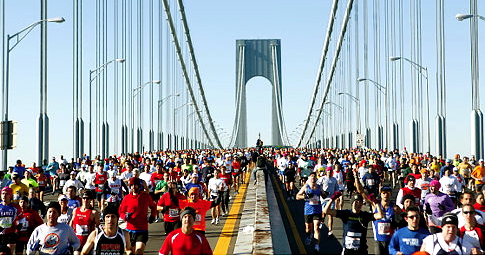
The packs of runners visible on many urban landscapes are a clear sign that distance road race season is upon us. As professional and amateur competitors get ready for their big events, lots of advice and suggestions are bouncing around the Internet.
One of the most common misconceptions is that athletes should over-hydrate before races to prevent illness. Don’t do this — drink according to thirst!…but I am getting ahead of myself here. In part 1 of this 2-part blog post let’s turn to the expertise of BJSM Associate Editor Professor Tim Noakes:
Individual susceptibility, rather than the environmental conditions, plays a much more important role in the development of heatstroke than previously acknowledged.
Humans have remarkable ability to exercise in the heat without health risk. This was brilliantly shown by the performance of the 40 kg Japanese runner, Mizuki Noguchi, who won the 2004 Athens Olympic Marathon for women in a time of 2 h 26 min 20 s despite the extreme environmental conditions—35°C with moderate humidity (watch video clip of race). However, heat injury, in particular heatstroke,can afflict persons exercising in much less severe environmental conditions when the total heat load cannot explain why heatstroke developed.
To prevent harm, it is important to be aware of the causes, presentation, and treatment of heatstroke and exercise-associated collapse and cramps.
Appropriate clinical assessment of the athlete who presents after exercising in the heat is the cornerstone of good management. In the past, there has been a tendency to initiate treatment before making a rational diagnosis. This position was taken partly because of the problem of high rates of admission to the medical tent at major events and partly because it was assumed that all athletes who collapsed were dehydrated and needed immediate intravenous hydration. The former problem can be overcome by a system of triage at events, and the latter assumption is not evidence-based (Noakes 2000).
Thus, the emergency treatment of life-threatening conditions, including heatstroke and hyponatremia, can safely be delayed for 1 or 2 minutes while the rectal temperature and the blood sodium concentration are measured and a reasonable working diagnosis is established. The obvious exception is cardiac arrest, which occurs uncommonly, and the diagnosis of which is unambiguous.
How severe is the heat illness?
Guidelines for determining the severity of the collapsed athlete’s condition
| Non-severe | Severe |
| Immediate assessment
Conscious Alert Rectal temperature: <40°C (104°F) Systolic blood pressure: >100 mmHg Heart rate: <100 beats/min |
Immediate assessment
Unconscious or altered mental state Confused, disoriented, aggressive Rectal temperature: >40°C (104°F) Systolic blood pressure: <100 mmHg Heart rate: >100 beats/min |
| Specialized assessment
Blood glucose level: 4–10 mmol/L (72–180 mg/dL) Serum sodium concentration: 135–148 mmol/L Body weight loss: 0–5%
|
Specialized assessment
Blood glucose level: <4 or >10 mmol/L (<72 or Serum sodium concentration: <135 or >148 mmol/L Body weight loss: >10% Body weight gain: >2% |
Tomorrow we outline the top 10 recommendations for the prevention of heat illness
In related news, 9 Japanese women were added to the elite London Marathon field as their World Championship trial was cancelled because of the earthquake and tsunami. Read more here
References: Noakes TD. Hyperthermia, hypothermia and problems of hydration. In: Shepard RJ, Astrand PO, editors. Endurance in Sport. Oxford: Blackwell Scientific, 2000:591-613.